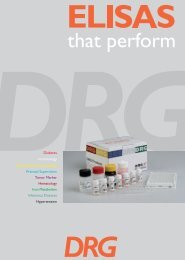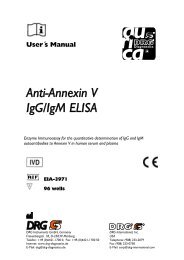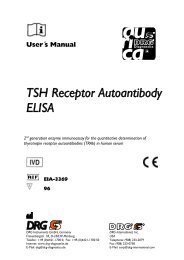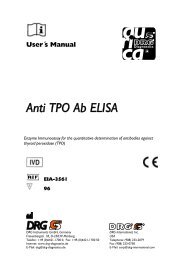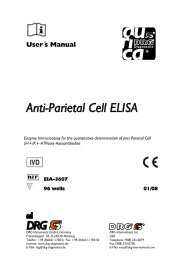Treponema pallidum (Syphilis) IgM ELISA - DRG Diagnostics GmbH
Treponema pallidum (Syphilis) IgM ELISA - DRG Diagnostics GmbH
Treponema pallidum (Syphilis) IgM ELISA - DRG Diagnostics GmbH
You also want an ePaper? Increase the reach of your titles
YUMPU automatically turns print PDFs into web optimized ePapers that Google loves.
9 ASSAY CHARACTERISTICS<br />
<strong>DRG</strong> <strong>Treponema</strong> <strong>pallidum</strong> <strong>IgM</strong> <strong>ELISA</strong> EIA-4267<br />
9.1 Diagnostic Specificity<br />
The diagnostic specificity is defined as the probability of the assay of scoring negative in the absence of the<br />
specific analyte.<br />
It is in revision.<br />
9.2 Diagnostic Sensitivity<br />
The diagnostic sensitivity is defined as the probability of the assay of scoring positive in the presence of the<br />
specific analyte.<br />
It is in revision.<br />
10 LIMITATIONS OF USE<br />
Bacterial contamination or repeated freeze-thaw cycles of the specimen may affect the absorbance values.<br />
In immunocompromised patients and newborns serological data only have restricted value.<br />
11 LEGAL ASPECTS<br />
11.1 Reliability of Results<br />
The test must be performed exactly as per the manufacturer’s instructions for use. Moreover the user must<br />
strictly adhere to the rules of GLP (Good Laboratory Practice) or other applicable national standards and/or<br />
laws. This is especially relevant for the use of control reagents. It is important to always include, within the<br />
test procedure, a sufficient number of controls for validating the accuracy and precision of the test.<br />
The test results are valid only if all controls are within the specified ranges and if all other test parameters are<br />
also within the given assay specifications. In case of any doubt or concern please contact <strong>DRG</strong>.<br />
11.2 Therapeutic Consequences<br />
Therapeutic consequences should never be based on laboratory results alone even if all test results are in<br />
agreement with the items as stated under point 11.1. Any laboratory result is only a part of the total clinical<br />
picture of a patient.<br />
Diagnosis of an infectious disease should not be established on the basis of a single test result. A precise<br />
diagnosis should take into consideration clinical history, symptomatology as well as serological data.<br />
Only in cases where the laboratory results are in acceptable agreement with the overall clinical picture of the<br />
patient should therapeutic consequences be derived.<br />
The test result itself should never be the sole determinant for deriving any therapeutic consequences.<br />
11.3 Liability<br />
Any modification of the test kit and/or exchange or mixture of any components of different lots from one test<br />
kit to another could negatively affect the intended results and validity of the overall test. Such modification<br />
and/or exchanges invalidate any claim for replacement.<br />
Claims submitted due to customer misinterpretation of laboratory results subject to point 11.2. are also<br />
invalid. Regardless, in the event of any claim, the manufacturer’s liability is not to exceed the value of the<br />
test kit. Any damage caused to the test kit during transportation is not subject to the liability of the<br />
manufacturer.<br />
12 REFERENCES<br />
1. Penn. C. W., M. J. Baily, and Cockayne. 1985. The axial filament antigen of <strong>Treponema</strong> <strong>pallidum</strong>.<br />
Immunology 54: 635-641<br />
2. Luger, A., B.L. Schmidt, und F. Gschnait. 1983. Neue Fortschritte der <strong>Syphilis</strong>serologie. Wr. Klein.<br />
Wsch. 95: 440-443<br />
Vers. 7.0 Effective 2009/11 – sl - 8 -



